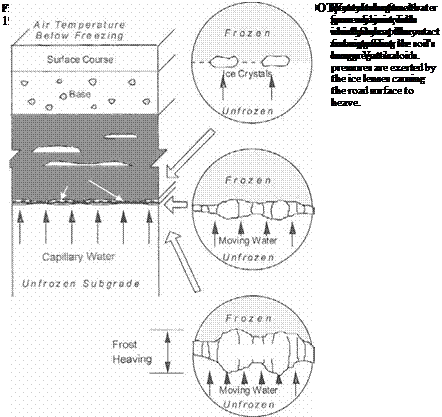Ice Lenses
Frost heaving of soil is caused by crystallization of ice within the larger soil voids. Ice lenses attract water to themselves by the, so-called, cryo-suction process, and grow in thickness in the direction of heat transfer until the water supply is depleted or until freezing conditions at the freezing interface no longer support further crystallization, see Fig. 4.3. As the freezing front penetrates deeper into the pavement, the growth of ice lenses ceases at the previous level and commences at the new level of the freezing front. At some point the heat flow will be reduced so that further freezing slows or the weight of overlying construction will impose sufficient stress to prevent further ice lens growth.
Fundamentally, the so-called cryo-suction process results from the consequences of the phase change of pore water into pore ice and the associated energy changes in the remaining pore water. As water arrives at the point of freezing, the soil skeleton expands to accommodate it while consolidation of the adjacent, unfrozen, soil may occur as water is pulled from that. The particular characteristics of the process are strongly affected by soil porosity, soil-water chemistry, stress conditions at the point of ice formation, temperature, temperature gradients in the adjacent soil(s), water availability, etc. Coussy (2005) gives a more detailed outline of the mass flow and heat flow elements that combine in the processes that are active at the freezing front.
 |
Capillary water is crucial for frost heaving. The pavement damage range depends on the rapidity of freezing, i. e. if freezing occurs rapidly, ice lenses are distributed over a greater mass of soil, which is somewhat more favourable compared to slow freezing where the capillary inflow of water will cause a high concentration of ice lenses. Frost heave primarily occurs in soils containing fine particles (i. e. frost – susceptible soils). Clean sands and gravel are non-frost susceptible because they cannot hold significant pore suctions, so water cannot be drawn to the freezing front through them. Silty soils represent the greatest problem. For even finer soils, like clays, the pores are very small. These small pores lead to a low coefficient of permeability which does not allow water to travel through the pores at a speed that would allow a fast capillary rise, hence ice lens formation is less.






Leave a reply